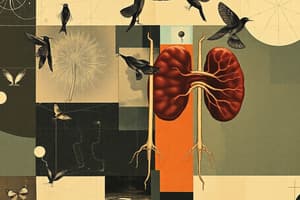Podcast
Questions and Answers
What is the primary function of the pituitary gland within the endocrine system?
What is the primary function of the pituitary gland within the endocrine system?
- Releasing insulin and glucagon
- Regulating blood pressure
- Filtering blood impurities
- Controlling the secretion of other hormones (correct)
What distinguishes steroid hormones from protein hormones?
What distinguishes steroid hormones from protein hormones?
- Steroid hormones can pass through cell membranes, while protein hormones cannot. (correct)
- Steroid hormones act more quickly than protein hormones.
- Steroid hormones originate only from the adrenal glands.
- Steroid hormones are water-soluble, while protein hormones are lipid-soluble.
Which structure serves an antagonistic role to the sympathetic nervous system?
Which structure serves an antagonistic role to the sympathetic nervous system?
- Somatic nervous system
- Parasympathetic nervous system (correct)
- Thalamus
- Cerebellum
During which phase of cellular reproduction does chromosomal crossing over occur?
During which phase of cellular reproduction does chromosomal crossing over occur?
What triggers the process of ovulation in the female reproductive system?
What triggers the process of ovulation in the female reproductive system?
Which of the following is a key feature of a reflex arc?
Which of the following is a key feature of a reflex arc?
Which part of the neuron is primarily responsible for receiving signals from other neurons?
Which part of the neuron is primarily responsible for receiving signals from other neurons?
Which cellular process is primarily responsible for producing gametes?
Which cellular process is primarily responsible for producing gametes?
Flashcards
Homeostasis
Homeostasis
A process that maintains a stable internal environment in an organism despite external changes.
Negative Feedback
Negative Feedback
A negative feedback loop is a homeostatic mechanism that counteracts a change, bringing it back to the original state.
Positive Feedback
Positive Feedback
A positive feedback loop amplifies a change, moving it further away from the original state.
Pituitary Gland
Pituitary Gland
Signup and view all the flashcards
Mitosis
Mitosis
Signup and view all the flashcards
Meiosis
Meiosis
Signup and view all the flashcards
Zygote
Zygote
Signup and view all the flashcards
Zygote
Zygote
Signup and view all the flashcards
Study Notes
Unit I: Maintaining Dynamic Equilibrium
- Homeostasis: Dynamic equilibrium, negative feedback, positive feedback
- Endocrine System: Diagram of organs; hormones, their roles, and effects (steroid vs. protein). Importance of pituitary gland (anterior and posterior); how insulin and glucagon work. Hormones related to stress (cortisol). Hormonal imbalances (hyper/hypo-secretion). Comparison of endocrine & nervous systems.
- Nervous System: Two divisions (CNS and PNS). Glial cells and neurons (sensory, motor, interneurons). Structure and function of neurons, myelination, saltatory conduction. Somatic and autonomic nervous systems. Reflex arc. Sodium-potassium pump's role in nerve impulse conduction. Synaptic transmission and neurotransmitters. Brain parts and functions (lobes). Spinal cord and peripheral nervous system (somatic & autonomic, including sympathetic and parasympathetic). Eye's structure and function, visual pathways.
Unit 2: Reproduction and Development
- Cellular Reproduction: Mitosis – its purpose and stages. Meiosis – its purpose and stages. Comparison of Mitosis and Meiosis. Cancer. Stem cells. Karyotypes and their uses. Common disorders identified with karyotypes.
- Sexual Reproduction: Importance. Gametogenesis. Fertilization (location). Embryonic development. Male and female reproductive systems (diagrams). Sperm pathway; Ovulation; Female reproductive cycle (hormones, phases). Reproductive technologies (contraceptives).
Unit III: Genetic Continuity
- DNA and Protein Synthesis: DNA composition & structure (chemical analysis, nucleotides). RNA & DNA differences. Replication, transcription & translation. Codon and anticodon. Amino acid sequences, mutation types.
- Genetics: Mendel's pea plants, genes, dominant and recessive traits. Laws of heredity (segregation & principle of dominance), independent assortment. Genotype/phenotype relationships (homozygous/heterozygous, alleles). Punnett squares (monohybrid & dihybrid crosses). Multiple alleles, incomplete dominance, codominance, sex-linked traits, blood types. Pedigrees.
Unit IV: Evolution
- Evolution: Darwin's role and theory of natural selection. Galapagos Islands observations (finches). Natural Selection postulates. Evidence of evolution (homologous & analogous structures, vestigial structures, fossils, fossilization). Gradualism vs. punctuated equilibrium, genetic variations. Adaptations, selective breeding, descent with modification. Importance of the fossil record.
Studying That Suits You
Use AI to generate personalized quizzes and flashcards to suit your learning preferences.
Related Documents
Description
Test your knowledge on maintaining dynamic equilibrium in biological systems. This quiz covers homeostasis, the endocrine system, and the nervous system's structure and function. Explore topics like hormones, neurons, and reflex arcs to deepen your understanding of these crucial biological processes.



